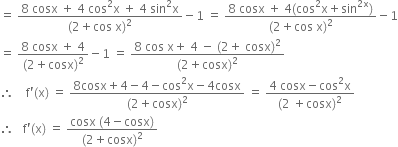 Long Answer Type
Long Answer TypeFind the intervals in which the function f is given by
В В В В В В В В В В В В В ![]()
is (i) increasing В В (ii) В decreasing
HereВ ![]()
![]()
В В В В В В В В В 
(i) For f(x) to be increasing.В
В В В В В В В В В В В В ![]()
![]()
(ii) For f(x) to be decreasing,
В В В В В В В В В 
В В В В В В В В
В В В В В В В
Determine the values of x for which the functionВ ![]() В is increasing and for which it is decreasing.
В is increasing and for which it is decreasing.
 Short Answer Type
Short Answer TypeLet I be any interval disjoint from (– 1, 1). Prove that the function f given by ![]()  is strictly increasing on I.
В is strictly increasing on I.
Find the intervals in which the function f given by f(x) = 2x2 – 3x is
(a) strictly increasing В В (b) strictly decreasing
Find the intervals in which the function f given by f(x) = x2 – 4x+6  is
(a) strictly increasing В В (b) strictly decreasing
Find the intervals in which the following functions are strictly increasing or decreasing:
x2+ 2x – 5
Find the intervals in which the following functions are strictly increasing or decreasing:
10 – 6x – 2x2
